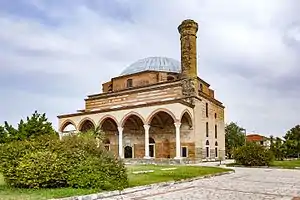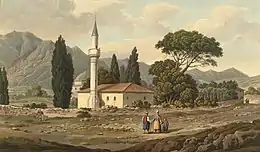Osman Shah Mosque
The Osman Shah Mosque (Greek: Τέμενος Οσμάν Σαχ) or Kursum Mosque (Κουρσούμ Τζαμί, from Turkish: kurşun camii, lit. 'Leaden Mosque') is a 16th-century Ottoman mosque in the city of Trikala in Greece.
| Osman Shah Mosque | |
|---|---|
Τέμενος Οσμάν Σαχ | |
 View of the mosque in 2016 | |
| Religion | |
| Affiliation | Islam |
| Location | |
| Location | Trikala, Greece |
 Location of the mosque in Greece | |
| Geographic coordinates | 39°33′0.38″N 21°46′16.13″E |
| Architecture | |
| Architect(s) | Mimar Sinan |
| Type | Mosque |
| Style | Ottoman architecture |
| Groundbreaking | c. 1566/67 |
| Completed | 1570 |
| Specifications | |
| Dome dia. (outer) | 18 m (59 ft) |
| Minaret(s) | 1 |
| Materials | Alternating layers of stone and brick |
Description
The mosque was commissioned by Osman Shah, also known as Kara Osman Pasha, who was the son of one of Sultan Selim I's daughters and the executed vizier İskender Pasha (died 1515). Osman Shah for a long time dwelt in Trikala as the governor of the local province, the Sanjak of Trikala.[1][2] The mosque was designed by the Ottoman imperial architect Mimar Sinan and is the only one that lies in modern Greece. [1]
The exact dating of the mosque is uncertain, but it was probably built in the period 1550–60, most likely in the late 1550s.[1][2] Osman attached several charitable establishments to the mosque, among others a madrasah, an alms house, and a caravanserai, and was himself buried in a türbe in the mosque's southern courtyard at the time of his death in 1567/8.[1] By the time of Evliya Çelebi's visit a century later, the mosque was the principal mosque of the city.[2]
It is also the only mosque still standing in the city of Trikala out of the at least eight that Evliya Çelebi reported seeing.[1][2] The building itself consists of a square prayer hall topped by a large 18 metres (59 ft) diameter semi-spherical dome.[3] The portico (revak) in front, was completely rebuilt in the renovations carried out in 1998.[3][4] The ashlar minaret is located on the northwestern corner and is well preserved, except for its missing roof. All other buildings attached to the mosque have since vanished, except for the founder's octagonal türbe (tomb), which is used as a storage site for artefacts recovered from archaeological excavations.[1]
References
- Mantzana, Krystallo. "Κουρσούμ Τζαμί: Περιγραφή" (in Greek). Hellenic Ministry of Culture. Retrieved 8 March 2014.
- Yerolimpos, Alexandra (2000). "Tirḥāla". In Bearman, P. J.; Bianquis, Th.; Bosworth, C. E.; van Donzel, E. & Heinrichs, W. P. (eds.). Encyclopaedia of Islam. Volume X: T–U (2nd ed.). Leiden: E. J. Brill. pp. 539–540. ISBN 978-90-04-11211-7.
- Necipoğlu 2005, pp. 442–443.
- "Osman Shah Camii". Archnet. Retrieved 2 December 2018.
Sources
- Necipoğlu, Gülru (2005). The Age of Sinan: Architectural Culture in the Ottoman Empire. London: Reaktion Books. ISBN 978-1-86189-253-9.


